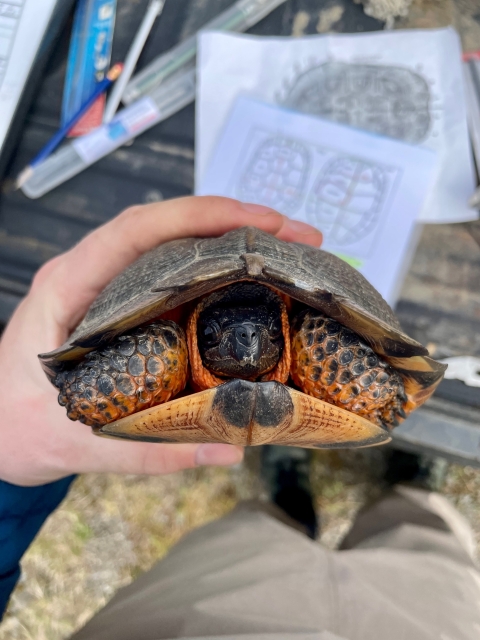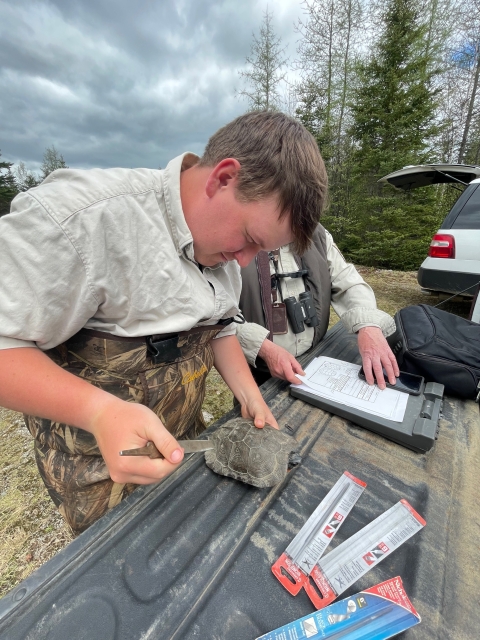A summer discovery was one to remember for the biological team and volunteers at the Northern Maine National Wildlife Refuge Complex. With an ideal weather window, the staff members and volunteers donned waders and set out to conduct their annual biological surveys, combing through thick forests, sandy-bottomed streams, and vernal pools in search of wildlife.
Northern Maine National Wildlife Complex is made up of three national wildlife refuges, including Sunkhaze Meadows, Moosehorn, and Aroostook National Wildlife Refuges, along with Carlton Pond Waterfowl Production area. Each protect valuable habitats like upland forests, grasslands, and wetlands, for a diverse array of wildlife. The complex can now count one more species in that array: the wood turtle. Although it had been spotted a few times before, the species was officially documented for the first time this summer.
Led by wildlife biologist Maurry Mills, interns Mac Mackenzie and Jack Brady, and volunteer Wayne Selfridge, the biological team was the perfect mix of experienced hands and fresh eyes to take on the annual survey of vernal pool and wetlands.
To Selfridge’s surprise, one vernal pool revealed a turtle he’d only seen once before in his life: a wood turtle that seemed to be patiently waiting to be discovered. The muddy, brown shell and orange surfaces of the turtle’s legs and neck were a sure sign Selfridge had spotted the rare species. The turtle was determined to be a female, around 15 years of age, and in good condition. The team recorded the turtle’s data and carefully notched her shell for identification before returning her to the edge of the vernal pool.
For Selfridge, it was the find of a lifetime. For the avid outdoorsman, hunter and fisherman with a passion for the woods, his biggest love was always turtles. After years of exploring and working in northern Maine, Selfridge was inspired to volunteer, grooming and maintaining the trails and supporting the biological team when navigating the remote woodlands and wetlands.
“I was so excited to discover a wood turtle, especially since they take it on the nose when it comes to their habitat and cars,” said Selfridge. "It was rewarding to make this find with a passionate group of interns who are focused on making conservation their careers. The future is in good hands.”
Riding the wave of excitement, the biological team headed back into the woods the next day to continue their surveys. To their great surprise, the second day of surveys led to the discovery of another wood turtle not far from where they found the first. Mac Mackenzie spotted the second wood turtle, this time a healthy male.
Mackenzie, a summer intern for the complex, reveled in the incredible discovery. He is studying wildlife ecology at the University of Maine, plans to become a herpetologist, and he wants everyone to understand how important it is to conserve rare and endangered species.
“Now we have evidence that wood turtles exist at the complex. Finding a male and female is so significant and gives us hope for the future of the species,” said Mackenzie. “Hopefully with future surveys, we can learn more about the species and how to best protect them."
This elusive turtle is native to 17 states throughout the northeast and west to Michigan and Minnesota, but they have been disappearing across the landscape. Because they depend on both terrestrial and aquatic habitats, wood turtles are vulnerable to habitat loss throughout their range. The wood turtle is designated as a Species of Greatest Conservation Need (SGCN) in all states where it occurs and has been petitioned for listing under the Endangered Species Act.
Wood turtles also face increasing threats from illegal collection and trade, crushing by agricultural equipment and cars when they travel from their streams to nest and forage – threats that exacerbate their ability to maintain or increase population sizes. Wood turtles can take more than 10 years to reach maturity, if they survive the perilous egg and hatchling periods where a high level of predation can occur. Few young turtles reach adulthood, meaning it can take a long time for turtle populations to recover from losses. Every adult turtle is extremely important for sustaining its population.
Discovering a new pair of turtles in a protected area, safe from human foot and road traffic, is a promising find for a species in decline.
“As for the future, we intend to conduct annual surveys now that we know we have wood turtles,” Mills said, adding that they may partner with Maine Department of Inland Fisheries and Wildlife to increase their capacity. “It was very exciting to find the first pair this year, and we look forward to learning more about their population in this area in the future.”
Whether new or experienced, volunteer or staff, everyone can make a difference in wildlife conservation. Learn how you can help turtles: https://www.fws.gov/story/how-you-can-help-turtles





